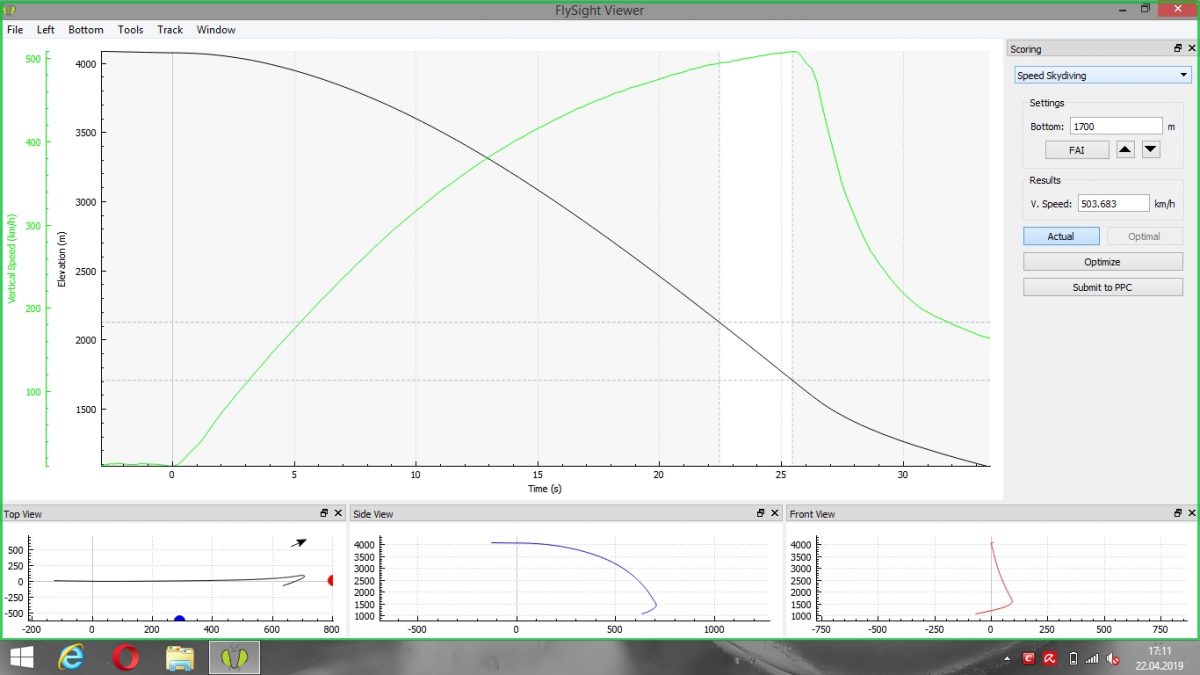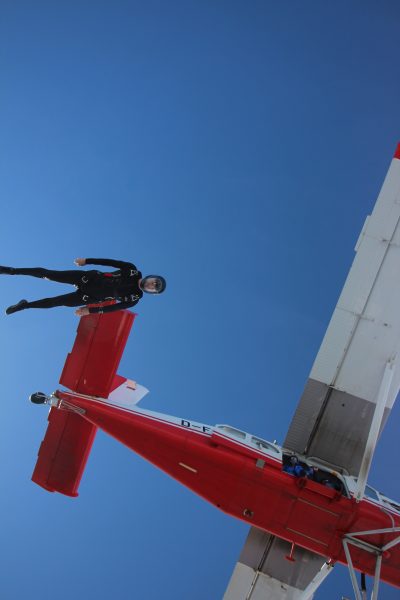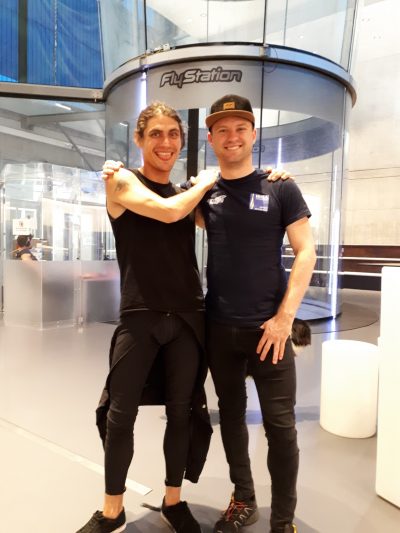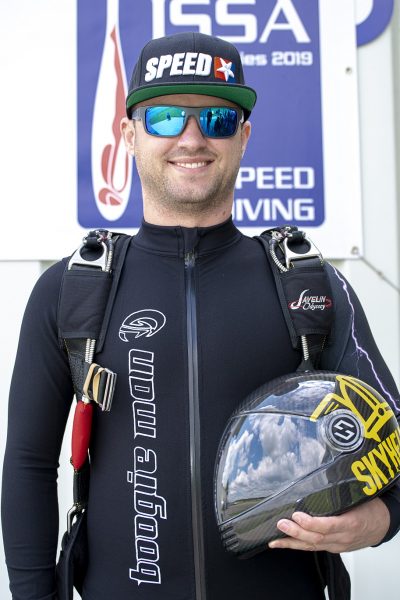
Skydiving at 500+ km/h – Marco Hepp explains Speed Skydiving
Tuesday, September 10, 2019
- Team CYPRES
- 9/10/19
- 0
- Education and training, General
What is speed skydiving?
The name says it all. From the term you can conclude that speed plays a decisive role and the best of the best fly faster than 500 km/h or 310 mph. That´s why we talk about speed skydiving as the fastest non-motorized sport in the world.
In speed skydiving, we measure the average freefall speed during a 3 seconds window between exit (4000m above the ground) and 1.700m above groundlevel. After flying through the lower measurement window, it is necessary to reduce your speed. With a highspeed of 500 km/h or more, you don´t want to open your parachute too early. To become that fast, you try to achieve the best aerodynamic bodyposition and hopefully keep it over the full jump and intuitively compensate the forces acting on your body and make no mistakes. Since 2019, we measure the speed of the jump with a GPS receiver (Flysight).
Since the middle of 1990´s, friends of speed skydiving have been meeting regularly, comparing their skills in self-organized competitions. After founding the International Speed Skydiviging Assosiation (ISSA), in the year 2000, the ISSA World Series took place every year. In those series, of currently 4 competitions, the fastest skydiver in the world is awarded. Since 2014, speed skydiving has been recognized as an official FAI discipline.

Stay safe!
At speeds of approx. 140 m/s, safety plays a key role. Only if you can walk away from the landing area unharmed, it was a good jump. The rig is very important. At such speeds, a premature opening has to be avoided at all costs. Well-fitting flaps and a high packing pressure should be mandatory. In addition, a very tight BOC and a cleanly hidden bridle are an absolute must haves!
A full face helmet can be an advantage at these speeds, but it´s not required. For the breaking point, a Dytter with the setting at the bottom end of the measuring window at 1.700m above the ground, is mandatory. Another altitude detector, ideally with LED light for visual indication, has established itself at the world level. At highspeed, it can happen easily that you don´t hear your Dytter, because of the noise.
The high freefall rate must be reduced after reaching the end of the measuring window. The easiest way to slow down the jump is a flat track. It also gives you the best feedback about the jump. The faster you accelerate forward, the faster you went.
Other safety points are discussed at the numerous speed camps and competitions. Thus, it is a good idea to get in touch with the discipline directly through such a format to learn from the best and to progress quickly, but above all, safely.
Training!

Speed skydiving is a science in itself. The jump sequence itself is not the problem, but the details matter. The personal body shape and the own equipment are very important. Thus, there is an ideal position for each jumper in which the perfect aerodynamic position is achieved. In order now to achieve the best results, it requires talent, discipline, motivation, experience and fun. It is not necessary to be tall or heavy. Everybody can reach it to the top, if she or he really just wants too. I, myself, am not that tall or heavy. Also I am not very experienced yet, but I have bite and can reflect myself very well.
How did I make it to the top of the world? Training, training, training!!
Before I go on a training jump, I make a plan. What would I like to work on today? What problem needs to be solved and how do I proceed?
After the jump, I write down my impressions in a training book. Then I analyze the GPS data and look at the graphs of the jump. In addition, I take notes of important key figures during the course of the jump in order to compare the individual jumps. Every training day, I get good 4 to 5 training jumps that meet my qualitative requirements. Overall, I can make about 150 to 200 speed jumps per year. But that alone can not make up for the lack of experience.
How can the windtunnel be helpful?

Since 2017, I fly indoor at Flystation Munich. With my coach Boris Peter, I work mainly on the flight feeling. LowSpeed Dynamic is the best way to learn to fly with your body and use everything you have. Boris develops special exercises that prepare me perfectly for upcoming competitions. Snakes and highspeed elements provide a good balance of intense exercises to improve the flight feeling. Floating also offers a good and easy exercise to feel and strengthen the body tension and the symmetry of the body axes. Just turn down the speed to a minimum and look at when you take off from the net. Intuitive flying improves the coordination of the muscles and the receptors of your skin. I try to get into the tube at least 30 to 60 minutes before any competition.
Grab a coach – it saves money!
What else to stay fit?
That’s not enough. If you want to go to the top, you have to continue working at home. I work about 50 hours a week in my job, to earn the money for my passion. In addition, I have set up a fitness program to withstand the stresses in the air. Injuries are the biggest enemy of progression. Pushups, planks, situps, neck exercises, dumbbell exercises help prepare the body for the strain. Approximately 30 minutes per day are necessary.
Competition!
The biggest fun you can get with speed are at competitions. To compete with your friends, to compare your speeds, there are plenty of opportunities at national and international competitions. At a competition, a total of 8 rounds have to be jumped, all of those jumps will count to your final score. The fastest jumper after all rounds wins. It is simple and very fair. Safety comes first and for that, there is a mature set of rules which have grown, during 20 years of experience. Especially newcomers are welcome in all competitions and are quickly added to the community. During a competition, it’s all about mental strength. Precisely because of the high power density at the top, you have to be perfectly prepared and in optimum shape to be on the podium at the end. Since this year, there is also a team ranking in which 3 previously defined jumpers are scored together. Speed Skydiving is a discipline that brings skydivers together. An incredible community is waiting for you.
About Marco

Marco Hepp is a 32 years young skydiver from Günzburg, which is in the south of Germany, near Ulm, right in the middle between Munich and Stuttgart.
He started skydiving in 2010 and his jump counter actually logs ~1500 jumps, of which ~900 are speed skydiving jumps.
Marco is member of the Speedteam Germany and currently no. 5 in the International Speed Skydiving Association (ISSA) wordwide ranking. His teammate is Moritz Friess, who holds no. 1!
You can read Marco’s portrait in the German skydiving magazine “freifallxpress”, issue 05-2019.
Tags: education, Marco Hepp, Moritz Friess, safety, Skydiver, Speed Skydiving
Adventure, Tips, and Adrenaline
Subscribe to Our Newsletter
By signing up for our newsletter you declare to agree with our privacy policy.

